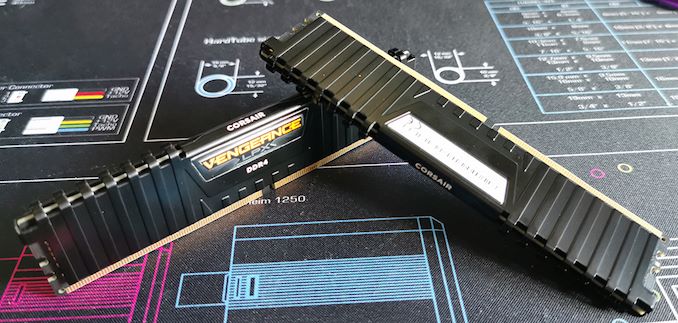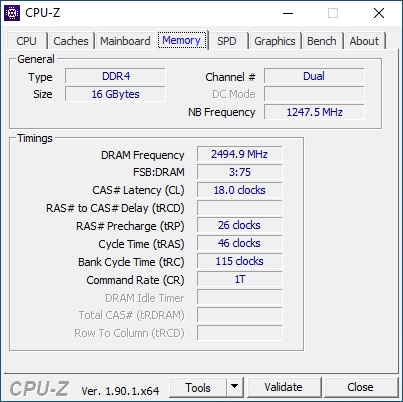The Corsair DDR4-5000 Vengeance LPX Review: Super-Binned, Super Exclusive
by Gavin Bonshor on January 27, 2020 9:00 AM ESTCorsair DDR4-5000 Vengeance LPX
When evaluating a memory kit that costs $1200, there’s one very obvious question: who is this for? Is it for gamers? Content creators? It’s certainly not for the price-conscious. There are some people with a practically unlimited amount of money who are willing to pay it for the very best, perhaps Corsair are doing it for them? Or perhaps it's just because Corsair can do it?
In our testing, we saw minimal gains in our compute-heavy tasks and in gaming when compared to DDR4-3200 and DDR4-3600. This is primarily down to the Infinity Fabric blockage which on our Ryzen 7 3700X, is around 1800 MHz. After this mark, it limits memory performance above DDR4-3600 (2:1 ratio on the FLCK). While we did see the benefit in our WinRAR and 7-Zip benchmarks which tend to scale well with memory, it comes down to the price. Is the extra $700 worth the 2.6 seconds saving in WinRAR from this DDR4-5000 kit from a DDR4-3600 kit? Performance in gaming between the speeds was inconsequential.
As for our experiences, the XMP for this kit includes only one profile – the advertised DDR4-5000. It’s much better to include this than require users to enter timings manually, but it’s not ideal that this is the only profile included. Other kits with a less extreme advertised speed sometimes include a second, lower XMP profile for the benefit of those whose CPU doesn’t have a strong enough memory controller to overclock to the full rated speed, and with DDR4-5000 being so hard to run we would have much preferred to see the same here. Users can of course just lower the memory ratio to run at a slower speed, but by providing a second XMP profile Corsair could have offered better-optimized latency timings at lower speeds.
To Validate or not to Validate
When it comes to extreme memory speeds, you don’t just need a high-quality motherboard capable of those speeds – you also need to make sure the board and memory are specifically qualified to work together. Unfortunately, unlike other memory vendors Corsair don’t publish a list of qualified motherboards, the kit is just listed as being for “X570”, but they have told us the modules were developed and validated on MSI’s X570 Godlike, MEG X570 Ace, MEG X570 Unify and Prestige X570 Creation. Motherboard vendors produce their own lists of qualified memory modules which you can check, and MSI’s website confirms that these modules are validated with their four top-end X570 boards.
SPD (Serial Presence Detect) refers both to a small physical EEPROM chip on a memory module, and the information stored on that chip. SPD information is used to signal what the capability of the memory is when a system boots, in order to configure the memory for fast and stable operation at stock speeds. The SPD can also optionally include extensions that store profiles for easy memory overclock, and on DDR4 Intel XMP has become a de facto standard with even modules designed specifically for AMD platforms relying on the Intel XMP specification to store overclock profiles. It should be stressed that although modules are rated to run at their XMP speed, it is still an overclock of the memory controller that isn’t guaranteed to run.
As far as stock operation, Corsair has rated these modules for DDR4-2666. This is disappointing in a modern enthusiast kit as the processors the kit is designed for support up to DDR4-3200 at stock speeds. A user who doesn’t take the time to configure an XMP overclock isn’t just going to find these modules slower than expected but will find them slower than far cheaper kits that are rated for DDR4-3200 at stock.
Without the option of a second XMP 2.0 profile to play with, it came down to the silicon gods whether or not we could boot at DDR4-5000 or not. Corsair told us that they had had the best luck with Ryzen 7 3700X CPUs. With our CPU, not once during testing could we just enable the XMP 2.0 on our MSI MEG X570 Ace and POST into Windows without copious amounts of errors. This is disappointing for a $1000+ kit of memory. To get the kit 100% stable, we needed to pump more than ideal levels of voltage through the processors SoC, up to 1.3 V was needed. We also check this kit on the ASRock X570 Aqua and ASUS ROG Crosshair VIII Impact to see if it would work despite not making the QVL list, and the kit did work, but we still required lots of SoC voltage for POST and stability.
It's clear that the Corsair Vengeance LPX DDR4-5000 isn't for every Ryzen 3000 processor. A user needs to determine if their CPU has a strong enough memory controller, or given that the user is spending $1200+ on memory, perhaps buying a couple of CPUs might be required, and then either sell/buy new others until a decent memory controller is found. In the case of our Ryzen 7 3700X testbed CPU, it was hit and miss. Yes, we did achieve DDR4-5000 with vast amounts of tweaks of settings and voltages in the firmware for our testing, but for the novice system builder, it's going to be playing a game of pot luck which for the price point.
Conclusion
The question may be, is this literally the fastest memory you can get? At retail, absolutely. In terms of raw MHz, it is. Practically speaking though, unless you’re already getting the absolute best in every other part of your system there’s no reason to spend such a huge amount on memory.
Corsair told us in their testing that actually the lower end Ryzen 3000 processors may have more success with memory stability, due to only having one chiplet, which puts less stress on the internal fabric. Higher core chips with two chiplets may have more issues due to overall heat and stress. It also comes down to the integrated memory controller on the chips: some are strong, some are weak, and it's a silicon lottery. There might be a day where memory vendors have to sell pre-binned CPUs with their high-end memory in order to ensure peak performance.
With this kit, Corsair is sending a clear message. The company wants us to know that their custom 8-layer PCB internal screening process and anodised aluminium heat spreaders are capable of producing memory that hits the highest speeds on the market. This is a team effort helped by AMD’s processors and MSI’s motherboards, but it’s undeniably very impressive. It's just a shame that AMD doesn't have a big APU to pair with it, as that's where I think we would see the biggest improvement in performance.












54 Comments
View All Comments
TheinsanegamerN - Tuesday, January 28, 2020 - link
While funny as a "what if" scenario, realistically nobody is going to pair a $150 APU with $1200 memory. AMD APUs likely couldnt push this stuff to 5000mhz anyway, hell most intel chips would struggle with 5000mhz.29a - Wednesday, January 29, 2020 - link
The only thing this memory would benefit is an APU, it would be nice just to see what it would do. Nobody is going to buy this memory for any reason other than bragging rights so they might as well had tested it with a APU.TomWomack - Monday, January 27, 2020 - link
Is there any way you could run Prime95 on this? It is spectacularly memory limited (on an i9-7940X for the largest FFT sizes it is barely 50% faster on 14 cores than on 4), so a best-case test.Alistair - Monday, January 27, 2020 - link
Seems like there is no point to this when buying a Threadripper and getting more memory channels gets you better results for less money.SanX - Monday, January 27, 2020 - link
Never seen on any website comparison of dual channel versus quad channel versus 6-channel versus 8-channel memory architectures. Instead all testers pump and pump and pump for years everyone know barely useful MHz because memory companies pay for the ad. You forgot 10% and even 20% difference in PC computing (and 2x in supercomputing) is essentially equal to ZERO difference?Take simple Gauss elimination Ax=B test from Intel XML library with AVX512 and compare different Intel processors, other tests and clear this question finally. May be even AMD processors which do not support ACX512 will shine here due to memory bandwidth.
eastcoast_pete - Monday, January 27, 2020 - link
Really puzzled by who would buy this outrageously expensive memory? The only use scenario I can imagine is in high-speed trading, where companies pay millions to be a few milliseconds ahead (for example, by getting their own fiber optic links to the CBE), but not sure if anyone in that field uses Ryzen systems.deneb - Tuesday, January 28, 2020 - link
This test would be great with threadrippers! Especially the 64 core.ManuelDiego - Tuesday, January 28, 2020 - link
Do these high speed RAM kits work at the advertised speeds when used with a Ryzen 3xxx series but on a B350 board? I know the memory controller is on the die, but i assume the traces on the board may also be a factor.Maxiking - Tuesday, January 28, 2020 - link
Could you please tell what sane person test impact of RAMS with AMDslow cpus and slow gpus? 5700xt? really?Did you outsource reviews to India?
catavalon21 - Tuesday, January 28, 2020 - link
Feel free to jump right in and write a better one.